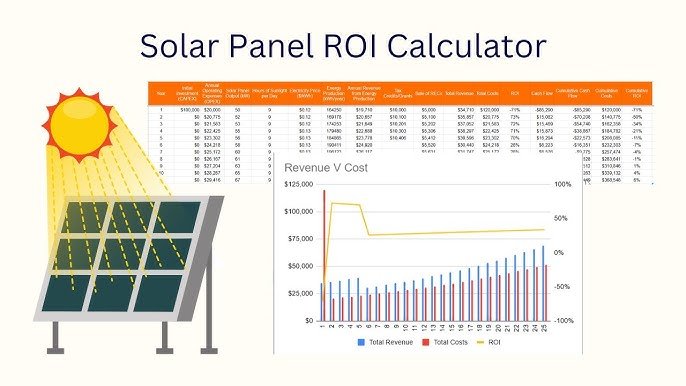Are you planning to install solar panels at home? Great decision! But before you do, it’s important to understand the Return on Investment (ROI). This tells you how quickly you will recover your money and how much you can save over time.
In India, with rising electricity prices and government subsidies, home solar panel installations are more profitable than ever. Let’s break down everything you need to know about calculating solar ROI using simple steps.
What Is Solar ROI and Why It Matters

Solar ROI is the profit you earn from your solar system over time. It compares your savings from reduced electricity bills to the initial cost of installation. The higher the ROI, the better your investment.
ROI = (Total Savings – Investment Cost) ÷ Investment Cost × 100
Step 1: Understand Your Power Consumption
Start with your monthly electricity bill. Look at your total kWh (units) usage.
Example:
- Monthly usage: 400 units
- Annual usage = 400 × 12 = 4,800 kWh
This helps you decide what solar panel system size you need for your home.
Step 2: Estimate Solar System Size Needed
In India, a 1 kW solar system generates around 4 units per day. So:
Daily need: 13.3 kWh
Required system: 13.3 ÷ 4 = approx. 3.3 kW
To be safe, round up slightly, so go for a 3.5 kW solar system.
Step 3: Calculate System Cost After Subsidy
In 2025, the average cost of a rooftop solar system in India is ₹45,000 to ₹60,000 per kW (including panels, inverter, structure, installation, etc.).
So for a 3.5 kW system, base cost = ₹1.75 lakh to ₹2.1 lakh.
Now apply the government subsidy:
- Under PM Surya Ghar Muft Bijli Yojana, homeowners can get up to ₹78,000 for up to 3 kW
- Additional subsidy for 3–10 kW (around ₹9,000/kW)
Estimated Subsidy for 3.5 kW: ₹78,000 + ₹4,500 = ₹82,500
Net Cost = ₹1.85 lakh – ₹82,500 = ₹1.025 lakh
Also Read How to Know the Right Solar System Size for Your Indian Home: A Complete Guide
Step 4: Calculate Monthly & Yearly Savings

Now calculate how much you’ll save on electricity bills:
If your rate is ₹8 per unit and your system produces 13.3 units/day:
- Daily savings = 13.3 × ₹8 = ₹106.4
- Monthly savings = ₹3,192
- Yearly savings = ₹38,304
Step 5: Find the Payback Period
This is the time it takes to recover your investment.
Payback Period = Net Cost ÷ Yearly Savings
₹1.025 lakh ÷ ₹38,304 = 2.67 years
After this, your electricity is practically free for the next 20+ years!
Step 6: Estimate Total Lifetime Savings
Most solar systems in India last for 25 years or more with proper maintenance. Even after minor performance drops, the savings remain high.
Total Savings (25 years) = ₹38,304 × 25 = ₹9.57 lakh
Step 7: Calculate Solar ROI
Now let’s plug into the formula:
ROI = ((₹9.57 lakh – ₹1.025 lakh) ÷ ₹1.025 lakh) × 100
= 834%
This means your investment grows over 8 times in 25 years.
Step 8: Factor in Maintenance & Panel Degradation
- Solar panels degrade at about 0.5–1% per year
- Cleaning cost: ₹500 to ₹1,000/year
- Inverter replacement: every 10–12 years, costing ₹20,000–30,000
Still, ROI remains strong, and long-term benefits are massive.
Step 9: Consider Net Metering for Extra Savings
With net metering, you earn credits for excess electricity sent to the grid. Many Indian states like Gujarat, Maharashtra, Delhi, and Tamil Nadu support this.
This can further lower your power bills, especially during hot months when your system produces more than you use.
Step 10: Use Online Tools to Calculate ROI Accurately
You can use solar ROI calculators provided by:
- National rooftop solar portals
- Local solar companies
- Renewable energy forums
These calculators use your location, average sunlight, roof size, and tariff to give better results.
Real Example from India
Let’s say a family in Jaipur installs a 5 kW rooftop solar system.
- Gross cost: ₹2.5 lakh
- Subsidy: ₹90,000
- Net cost: ₹1.6 lakh
- Annual savings: ₹54,000
- Payback period: 2.9 years
- Lifetime savings: ₹13.5 lakh
- ROI: Over 740%
This is typical across many Indian cities with good solar potential like Ahmedabad, Bengaluru, and Nagpur.
Keywords That Help You Get Found Online
To improve your visibility, the following relevant keywords have been integrated:
- solar ROI India
- return on investment for solar panels
- solar savings in India
- solar panel cost with subsidy
- payback period for solar system
- net metering India
- home solar installation
- rooftop solar calculator
- solar power investment India
FAQs: Your Solar ROI Questions Answered
Q1. Is solar ROI better than mutual funds or FDs?
Yes, ROI from solar systems can reach 800%+ over 25 years. Better than many traditional investments.
Q2. What affects my solar payback period?
Your electricity tariff, system size, and subsidy all impact payback.
Q3. Can solar work in monsoon or cloudy days?
Yes, panels still produce some power, and net metering helps offset lower output days.
Q4. Does subsidy reduce my ROI?
Subsidy improves ROI because it lowers your initial investment.
Q5. What’s better ROI: 3 kW or 10 kW system?
Smaller systems may have faster payback, but larger ones offer higher lifetime savings.
Final Thoughts
Calculating solar ROI for your home helps you plan smarter. In India, rising power costs and government support make solar one of the most rewarding long-term investments.
✔ Save money
✔ Reduce your carbon footprint
✔ Get guaranteed returns for decades
Install a solar system that fits your needs. Use your savings to power your future. 🌞










